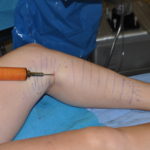Augmentation of the calfs is most consistently done with a synthetic implant. Most patients who seek calf augmentation are typically body builder types, those born with very thin calfs who have been unable to build them up, or sosmeone with significant calf asymmetry. Despite an implant’s predictable improvement in the size and shape of the calfs, calf implants are not without problems. Implant placement into and on top of the calf muscles makes recovery uncomfortable and having to stand and walk around early on afetr surgery makes it possible for the implant to shift, develop a fluid collections (seroma) or possibly even get infected.

All of these advantages of free fat fat grafting is counterbalanced by one significant disadvantage….an unpredictability of after surgery shape and size. How much fat survives and is retained is widely variable. No plastic surgeon can guarantee or predict with 100% accuracy how much fat will survive on a consistent basis. The article reports using 75 – 125cc per calf with good volume retention.The burning question through the past several decades is…how to make fat grafting work better. The injection technique is, of course, important but is only half of the answer. How the fat is prepared after harvest in the oeprating room is the other half. Everyone agrees that concentration is very important after harvest. This is the mechanical process of removing the liquids from the more solid fat components. Whether this is done by a centrifuge or passing the fat aspirate through a strainer or sieve are two methods of which one has not been proven to be better than the other. Additives to the fat are theoretically appealing but there is no universal magical additive. Currently, I add platelet-rich plasma (PRP) to the concentrated fat prior to injection. Whether this aids fat survival is not proven but since it is a product of the patient, there is no risk in so doing. PRP is a concentrate of a patient’s own blood done at the time of surgery. While there is no standardized amount of PRP to add to fat, I would envision adding 3cc of PRP per calf graft site.
Having done a few cases of calf augmentation with fat injections, the technical aspect of this approach is straightforward. Careful marking of the patient while standing beforehand is critical to get the proper areas augmented. Like all fat injection surgeries, the patient must accept that the amount of fat that will survive is unpredictable. It may require more than one injection session to obtain the best result. Most fat grafting methods will not achieve the degree of volume enhancement that a calf implant will. In reviewing the before and after photos from the above mentioned article, that observation seems to be true.
Dr. Barry Eppley
Indianapolis, Indiana


